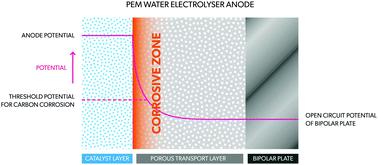当前位置:
X-MOL 学术
›
Energy Environ. Sci.
›
论文详情
Our official English website, www.x-mol.net, welcomes your
feedback! (Note: you will need to create a separate account there.)
Assessing potential profiles in water electrolysers to minimise titanium use
Energy & Environmental Science ( IF 32.4 ) Pub Date : 2022-05-10 , DOI: 10.1039/d2ee00876a Hans Becker 1 , Edmund J. F. Dickinson 1 , Xuekun Lu 1, 2 , Ulf Bexell 3 , Sebastian Proch 3 , Claire Moffatt 3 , Mikael Stenström 3 , Graham Smith 1 , Gareth Hinds 1
Energy & Environmental Science ( IF 32.4 ) Pub Date : 2022-05-10 , DOI: 10.1039/d2ee00876a Hans Becker 1 , Edmund J. F. Dickinson 1 , Xuekun Lu 1, 2 , Ulf Bexell 3 , Sebastian Proch 3 , Claire Moffatt 3 , Mikael Stenström 3 , Graham Smith 1 , Gareth Hinds 1
Affiliation

|
The assumption of a highly corrosive potential at the anode bipolar plate (BPP) and porous transport layer (PTL) in a proton exchange membrane water electrolyser (PEMWE) stack often leads to selection of expensive materials such as platinum–coated titanium. Here, we develop a physicochemical model of electrochemical potential distribution in a PTL and validate it by in situ and ex situ electrochemical potential measurement. Model predictions suggest that, under typical PEMWE operating conditions, the corrosive zone associated with the anode polarisation extends only ≈200 μm into the PTL from the catalyst layer, obviating the need for highly corrosion-resistant materials through the bulk of the PTL and at the BPP. Guided by this observation, we present single cell PEMWE tests using anode current collectors fabricated from carbon-coated 316L stainless steel. The material is shown to be tolerant to potentials up to 1.2 V vs. RHE and when tested in situ for 30 days at 2 A cm−2 showed no evidence of degradation. These results strongly suggest that much of the titanium in PEMWEs may be substituted with cheaper, more abundant materials with no loss of electrolyser performance or lifetime, which would significantly reduce the cost of green hydrogen. The combined modelling and experimental approach developed here shows great promise for design optimisation of PEMWEs and other electrochemical energy conversion devices.
中文翻译:

评估水电解槽中的电位曲线,以尽量减少钛的使用
假设质子交换膜水电解器 (PEMWE) 堆栈中的阳极双极板 (BPP) 和多孔传输层 (PTL) 具有高度腐蚀电位,通常会导致选择昂贵的材料,例如镀铂钛。在这里,我们开发了 PTL 中电化学电位分布的物理化学模型,并通过原位和非原位验证电化学电位测量。模型预测表明,在典型的 PEMWE 操作条件下,与阳极极化相关的腐蚀区仅从催化剂层延伸到 PTL 约 200 μm,从而消除了对穿过大部分 PTL 和在BPP。在这一观察的指导下,我们使用由碳涂层 316L 不锈钢制成的阳极集电器进行单电池 PEMWE 测试。该材料被证明可以耐受高达 1.2 V vs的电位。RHE 和当在 2 A cm -2下原位测试 30 天时没有表现出退化的迹象。这些结果强烈表明,PEMWE 中的大部分钛可以用更便宜、更丰富的材料替代,而不会损失电解槽性能或寿命,这将显着降低绿色氢的成本。这里开发的组合建模和实验方法显示了 PEMWE 和其他电化学能量转换装置的设计优化的巨大希望。
更新日期:2022-05-11
中文翻译:

评估水电解槽中的电位曲线,以尽量减少钛的使用
假设质子交换膜水电解器 (PEMWE) 堆栈中的阳极双极板 (BPP) 和多孔传输层 (PTL) 具有高度腐蚀电位,通常会导致选择昂贵的材料,例如镀铂钛。在这里,我们开发了 PTL 中电化学电位分布的物理化学模型,并通过原位和非原位验证电化学电位测量。模型预测表明,在典型的 PEMWE 操作条件下,与阳极极化相关的腐蚀区仅从催化剂层延伸到 PTL 约 200 μm,从而消除了对穿过大部分 PTL 和在BPP。在这一观察的指导下,我们使用由碳涂层 316L 不锈钢制成的阳极集电器进行单电池 PEMWE 测试。该材料被证明可以耐受高达 1.2 V vs的电位。RHE 和当在 2 A cm -2下原位测试 30 天时没有表现出退化的迹象。这些结果强烈表明,PEMWE 中的大部分钛可以用更便宜、更丰富的材料替代,而不会损失电解槽性能或寿命,这将显着降低绿色氢的成本。这里开发的组合建模和实验方法显示了 PEMWE 和其他电化学能量转换装置的设计优化的巨大希望。











































 京公网安备 11010802027423号
京公网安备 11010802027423号